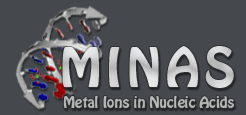MINAS – A Database of Metal Ions in Nucleic AcidS
Joachim Schnabl, Pascal Suter, Roland K. O. Sigel
Institute of Inorganic Chemistry, University of Zürich, Winterthurerstrasse 190,
8057 Zürich, Switzerland. email: joachim.schnabl@aci.uzh.ch
The tertiary structures of large polyanions like DNA or RNA (e.g. ribozymes) are of a highly complex architecture containing hairpins, loops and many other local structures. For charge compensation and to reach this complex fold, mono- and divalent metal ions like Na+, K+, Mg2+, or Ca2+ are a prerequisite. Metal ions thereby coordinate to the phosphate oxygens as well as to the various functionalities on the nucleoside moieties, like N7, carbonyl oxygens, or OH groups.[1] Nucleic acids achieve a surprising selectivity and specificity for a certain kind of metal ion despite the small variety of nucleotides and wide distribution of coordination sites throughout the oligonucleotide.[1]
In order to elucidate the origin of this selectivity, we have built a new database MINAS – Metal Ions in Nucleic AcidS[2] that contains the exact geometric information on the first and second-shell coordinating ligands of every metal ion present in nucleic acid structures that are deposited in the PDB and NDB. Containing also the sequence information of the binding pocket-proximal nucleotides, this database allows for a detailed search of all combinations of potential ligands and of coordination environments of metal ions. MINAS is therefore a perfect new tool to classify metal ion binding pockets in nucleic acids by statistics and to draw general conclusions about the different coordination properties of these ions.
Financial support by the Swiss National Science Foundation (SNF-Förderungsprofessur to RKOS PP002-68733/1) is gratefully acknowledged.
[1] E. Freisinger, R.K.O. Sigel, Coord. Chem. Rev. 2007, 251, 1834-1851.
[2] <www.aci.uzh.ch/rna> or <www.minas.uzh.ch>

